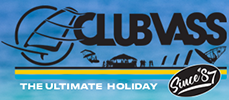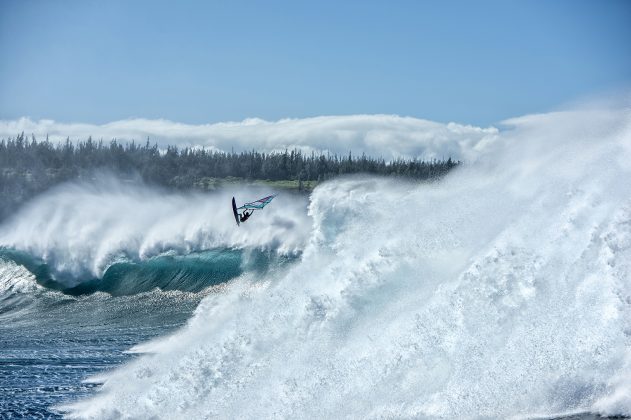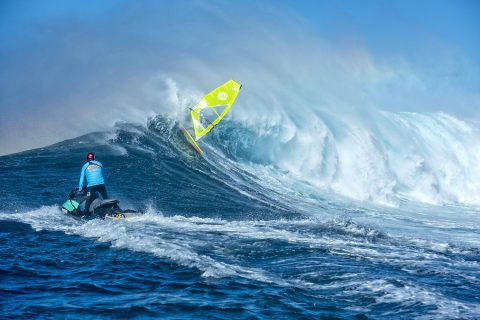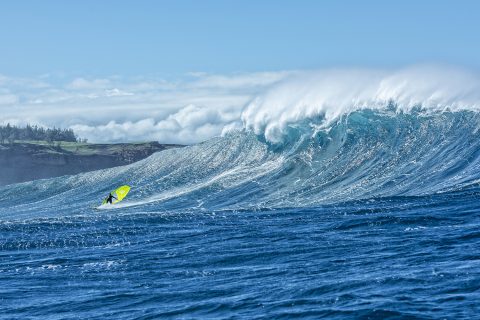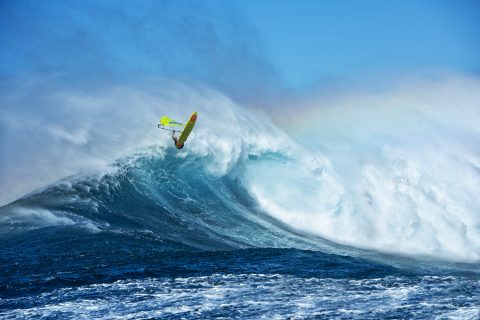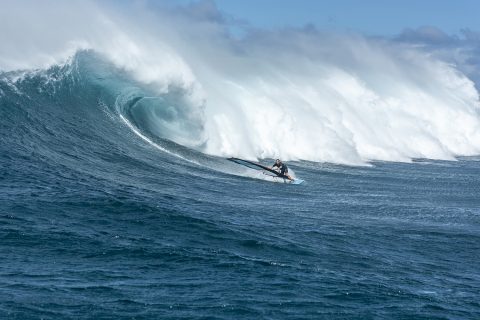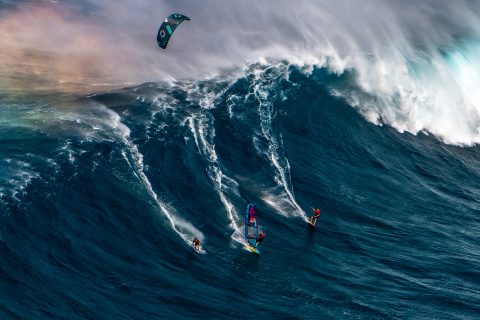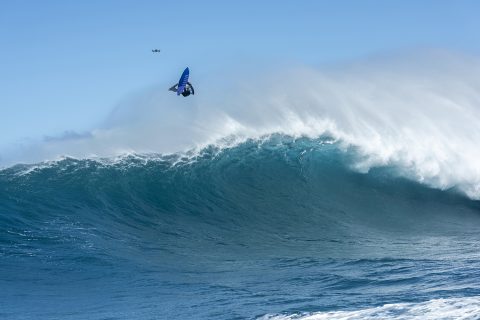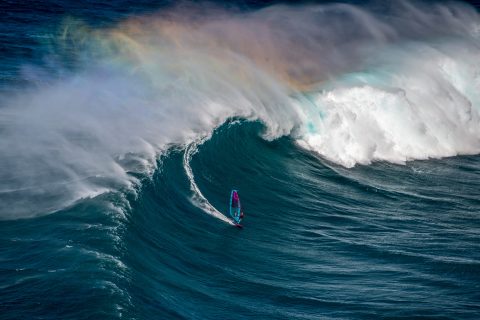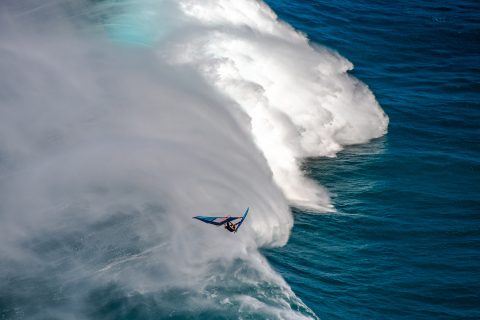A XXL journey
Maui based chargers Marcilio Browne and Robby Swift tell us about their journey from first time sailing Peʻahi, a.k.a. Jaws, to the present day.
WORDS – Marcilio Browne, Francisco Goya and Robby Swift // PHOTOS – Fish Bowl Diaries and Daniel Sullivan.
FIRST TIME
Marcilio Browne – “When I was a kid Jaws terrified me so much that I didn’t even think about sailing there; it wasn’t one of my goals at all. But after moving to Maui and spending so much time here, you slowly get used to bigger waves and I started taking baby steps towards sailing Jaws and had my first session there in 2009.
My first time was so scary. We made the decision to go for it 5 or 6 days before and I was a total wreck. I didn’t know what to expect, what board to use or how to get there … I was shitting my pants for a week basically. But it turned out to be such an amazing experience. Micah Buzianis took Ricardo Campello and I on his jet ski and Antoine Albeau also came with us. There we met with the most awesome crew of guys – Josh Stone, Francisco Goya, Keith Teboul and Jason Prior. There was not much paddle surfing at that stage at Jaws, so the lineup was pretty empty, which when I look at how busy it is now, it was incredible to have it so quiet back then. The wind was light for most of the day, so we were waiting around for 4 or 5 hours watching guys tow surf, until around 4 p.m. a cloud came and it got windy. I got 2 or 3 waves, did one little turn and came back home beyond stoked!!! The whole experience blew my mind. On the way back our skis broke down and lucky for us Josh Stone gave us a ride back on his boat, it was such a good feeling being around all those guys after a day like that.”
- Brawzinho at Jaws. Photo: Fish Bowl Diaries
INSIGHT
Francisco Goya recounts Marcilio’s first session – “On that day I watched Braw (Marcilio) dropping in as I was pulling out and wanted nothing to do with those 2 or 3 sets he got. From that day you could already see Braw’s focus at Jaws, and how he made those mountains of moving water look playful.”
- Marcilio Browne Jaws: Fish Bowl Diaries
PRESENT DAY
Marcilio Browne – “Jaws is completely different nowadays. Every time we go there it’s a complete circus pretty much – so many boats, skis and sports. It’s probably the most famous wave on the planet and everyone is there at the same time. My approach now is so different, I am a lot more organized these days. I always have a safety guy watching out for me on a second ski, plenty of hydration/food and inflation vests. Boards and sails are so much better now and I do feel fitter now than I did back when I was 20, thanks to Sarah Hauser. We get a bit smarter as we get older with food, recovery and all that. So pretty much every time we go I plan on being there from 11 a.m. to 4:30 / 5 p.m. That’s kind of the wind window and I want to maximize every chance I have. It’s hard to get waves there this days as it’s crowded with tow, paddle and kite. So just getting on a wave is a full on mission, so I really try to be out the whole day and that way you get those moments where conditions get a little better. People get a little tired and go in, but you have to be there and be ready, as those moments don’t last long. These days I also have special boards to go there, and having someone looking out for you really helps mentally to go for it a little more too.
- Big air at Jaws Photo: Fish Bowl Diaries
EQUIPMENT
So in the past I used to ride a board that is 240 by 56 cm wide with a round pin tail. I have had this board for so many years and always came back to it after trying different things. For the recent swell that I rode in the pictures, I tried something very different. The board was 233 by 57 cm wide with a fish tail. I also choose to ride slightly smaller fins because of all the lift Jaws creates with that speed, I went 14 and 9 cm fins, instead of 14.5 and 9, both K300 MFC model.
Those changes felt really good that day, especially riding the west bowl where the winds are a bit more offshore as the wave angles towards you. It felt like the board was fitting in a little better and easier to transition from one rail to another. I am curious to see how this board will handle a really massive day, which it wasn’t this time!”
ROBBY SWIFT
“Jaws is a special place for me and for just about anyone else in the world who is into surfing or windsurfing big waves. It’s the pinnacle of big wave surfing and windsurfing and is probably the most famous big wave location in the world. It’s definitely one of the most beautiful waves in the world and has a mythical feel to it like no other place I have ever been. Every kid on Maui who surfs grows up dreaming of surfing there one day. I was no different. I remember looking at the photos of Robby Naish, Jason Polakow, Bjorn Dunkerbeck and Josh Stone in the “Riding Mountains” series of photos when I was about 12 years old and dreaming of doing the same one day.
- Robby Swift: Photo: Fish Bowl Diaries
EARLY DAYS
Of course when I came to Maui when I was 15 I thought about it all the time. Back then Josh Stone and Jason Polakow were my mentors and Josh very wisely told me that you need to be comfortable hitting 10 foot lips (that’s 20 foot faces – when you talk to someone in Hawaii they say 10 foot) at Ho’okipa and crashing and not be phased by that before you are ready to go up to Jaws, so I took that to heart and started trying to prepare myself for it.
I think I actually tow surfed before I windsurfed there for the first time. I believe it was in 2002 so I would have been 18. I made it into the coveted “Surfing Jaws” calendar in 2008 (I think the photo was from 2005 though) and I still see that calendar available to buy in Mana Foods, our local health food shop on Maui, so it makes my kids proud when they see their dad in there!
- Two is company three is a crowd! Photo: Daniel Sullivan
PREPARATION
I wouldn’t call it a complete obsession for me, surfing and windsurfing Jaws, as I have other kinds of windsurfing and surfing on my mind all summer, but when winter comes it is certainly in the forefront of my mind. I like to be comfortable when I go there, so I start my breath hold training well in advance of the first swells, normally in September, so that I’m ready and able to hold my breath for 3 minutes or so without any issues. We also get our jet ski prepared and up to date at that time of year and we are always amped to go up there for the first time.
- Robby Swift goes Big: Photo: Fish Bowl Diaries
COMFORT LEVELS
I have definitely become more comfortable with Jaws over the years, as you do with anything that you spend a lot of time preparing for and doing, but I would absolutely not say that the fear and apprehension before a big day has by any means dissipated. To give you an example, the last day we were up there and the pictures are from, I was sailing for 4.5 hours and I don’t think my heart rate dropped below 130 for the entire session. Normally when I’m floating out the back at Ho’okipa waiting for a wave, it goes down to 95 or 100. The peak at the end of the wave is always well up in the 170s!
FIRST SESSION
My first session windsurfing at Jaws was a bit of an anticlimax after getting some epic waves tow surfing there. It was much harder to catch the wave than I could possibly have imagined and I only got 3 or 4 waves. It’s so hard to even drop down the wave when the wind is so offshore and the waves come so much from the west, that without the right equipment you are pretty much stuffed. Back then, we ordered longer and longer boards with weight in them and they were pretty narrow (about 54 cm I seem to remember) and were 8’6” / 260 cm long. I definitely was not as prepared as I am now with breath holding etc., but I was only 18 and didn’t have kids so was quite a bit more ‘radical’ then, so I didn’t really care.
MISHAPS
We have had plenty of mishaps over the years with jet skis not being tied up properly (I have since learned to tie very nice bowlines), and anchors not grabbing the sea floor properly (we have practiced that too). So we lost a couple of jet skis on the rocks in the early days. Not my skis (thankfully), but people I went with. I am a lot more careful with everything in my wise old age of 37 now and I try to have everything nice and prepared before I go.
ANALYZE
Now that I have been sailing up there for 20 years, I have had plenty of time to look at my waves and analyze what I could do better. Obviously Brawzinho is the man to watch up there. His critical attack on the wave looks completely surreal when you watch it in person up close. There is no way any photo or video can do that justice.
I am not sure that I really want to hit lips as late as he has in the past (admittedly every time he has done it, it has actually been a mistake and happened by chance), but I don’t really think I want to put myself in that position. I do however think that windsurfing is the absolute best way to surf Jaws as far as turning performance goes (getting barreled on a surfboard would of course be the absolute best thing you can do, but turns on a windsurfer are next in my opinion) and I want to push my performance in that area as much as possible. This does inevitably leave you in some situations where you have to do an aerial to make the wave, or to get out of the way of the destructive forces that you have put yourself in front of, hence the several big aerials I have done over the past couple of years.
- Robby Swift: photo: Daniel Sullivan
POSITION
I watch the videos of myself sailing there before I go up and I remind myself where I want to position myself on the wave, (always way deeper than I think I should be). It is so deceptive when you are actually on that wave because it really feels like you are miles too deep and you are never going to make it every time you manage to drop into a wave. The fact is though, that the wave ‘horseshoes’ around in one big curve and the peak grows exponentially as it does so, meaning that you can actually be much deeper than you think on almost every wave. It takes years of experience though to drum it into yourself that it is ok to go so deep on the waves because it is so crazy scary.
KIT
As far as equipment design goes now, I actually used a new prototype for the JP Ultimate Wave production board on the last session up there. It is an 88-litre, 59 cm wide and 222 cm long if you can believe it, so 38 cm shorter than my old Jaws boards. I think the performance of the new boards, with the wider outlines and the concave in the bottom, really lends itself to big waves so you can get away with less length. The extra width lets you get onto the plane early and be able to catch the waves without needing such a long rail line, and then the bottom shape really helps you to be able to trust yourself in turns at super high speeds. I only had one afternoon sailing there on that board and the waves weren’t off the scale gigantic like they were back in 2021, but I felt really comfortable and felt like I had some of my best turns that I have had up there. I can’t wait to try that board out again on a bigger day and to remind myself to go even deeper!
CROWDS
As far as crowds go, Jaws is a place where you get only the really best guys out there, so everyone knows what they are doing and that is good. The problem is that everyone is trying to get ‘that’ shot for their social media / print media / sponsors and it gets pretty hectic. There are rules about how close you can go to another vessel on a jet ski when tow surfing, but they get completely ignored up at Jaws. The guys sit right inside on their jet skis, way deeper than you can sit on a windsurfer to catch the waves, and then come across the wave and physically push you out of the wave on their jet skis. It’s really dangerous and extremely scary. If you get pushed out the back of a wave and there is a bigger one behind, or a more ‘west’ one, then you are completely done for as there is no wind at all behind the waves so you can’t escape. Then there are the kiters who can catch any wave from miles out to sea, so they take most of the waves and the windsurfers are left kind of wallowing.
Thankfully a lot of the really good guys know about the etiquette in the water and let the windsurfers go when they can catch one as it’s so hard to get one. The windsurfers definitely give way to the paddle surfers (as they should) and it would be really nice if the tow surfers would always give way to windsurfers as they should. We will see how that situation evolves. I understand that people’s careers are made on big days at Jaws, so there is a lot of energy in the water, but I’m always hopeful that people will ‘do the right thing’!
- Aerial action from Swift: Photo: Daniel Sullivan
SAFETY
For safety, we always hire somebody to drive on a jet ski the whole time and watch us and make sure we are ok. We have no more than 3 people per safety driver (in case someone goes down on one wave and someone else falls on the wave behind). There are always the Hawaiian Water Patrol up there and they are incredible people to have watching out for you. They are contracted to take care of certain surfers though, so it is absolutely not ok to rely on them coming to help you and take no safety driver of your own. Of course the boys will always come and rescue you if it’s life or death, but it’s not fair to rely on someone else’s safety driver to come and get you and ‘pay if you need it’ so to speak. There have been several issues with windsurfers doing that and getting in trouble and if you think about it logically it’s definitely not fair. You pay for the safety guy as a kind of ‘insurance’ that you hope you don’t have to use. You shouldn’t just think you can ‘opt in’ to the insurance if you need it one day!
QUALITY
So all in all, Jaws is, in my opinion, the best big wave in the world to surf or windsurf as far as quality of wave, direction of wind and safety (thanks to the big channel). It’s so perfect that it’s quite predictable and you can really push your level as far as you are comfortable to push it without having to worry about all kinds of external factors like the wave moving around all over the place (Nazaré) or there being no channel to escape to.”

